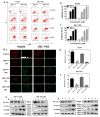Novel Bradykinin Receptor Inhibitors Inhibit Proliferation and Promote the Apoptosis of Hepatocellular Carcinoma Cells by Inhibiting the ERK Pathway
- PMID: 34206871
- PMCID: PMC8272207
- DOI: 10.3390/molecules26133915
Novel Bradykinin Receptor Inhibitors Inhibit Proliferation and Promote the Apoptosis of Hepatocellular Carcinoma Cells by Inhibiting the ERK Pathway
Abstract
Hepatocellular carcinoma (HCC) is the fifth most common cancer worldwide. Studies have shown that bradykinin (BK) is highly expressed in liver cancer. We designed the novel BK receptor inhibitors J051-71 and J051-105, which reduced the viability of liver cancer cells and inhibited the formation of cancer cell colonies. J051-71 and J051-105 reduced cell proliferation and induced apoptosis in HepG2 and BEL-7402 cells, which may be due to the inhibition of the extracellular regulated protein kinase (ERK) signaling pathway. In addition, these BK receptor inhibitors reversed the cell proliferation induced by BK in HepG2 and BEL-7402 cells by downregulating B1 receptor expression. Inhibiting B1 receptor expression decreased the protein levels of p-ERK and reduced the malignant progression of HCC, providing a potential target for HCC therapy.
Keywords: ERK signaling pathway; apoptosis; bradykinin B1 receptor; bradykinin receptor inhibitor; hepatocellular carcinoma.
Conflict of interest statement
The authors declare no conflict of interest with the contents of this article.
Figures





Similar articles
-
Caffeine inhibits the proliferation of liver cancer cells and activates the MEK/ERK/EGFR signalling pathway.Basic Clin Pharmacol Toxicol. 2008 Jun;102(6):543-51. doi: 10.1111/j.1742-7843.2008.00231.x. Epub 2008 Mar 16. Basic Clin Pharmacol Toxicol. 2008. PMID: 18346049
-
Anlotinib induces hepatocellular carcinoma apoptosis and inhibits proliferation via Erk and Akt pathway.Biochem Biophys Res Commun. 2018 Sep 18;503(4):3093-3099. doi: 10.1016/j.bbrc.2018.08.098. Epub 2018 Aug 23. Biochem Biophys Res Commun. 2018. PMID: 30146257
-
Tunicamycin inhibits cell proliferation and migration in hepatocellular carcinoma through suppression of CD44s and the ERK1/2 pathway.Cancer Sci. 2018 Apr;109(4):1088-1100. doi: 10.1111/cas.13518. Epub 2018 Feb 26. Cancer Sci. 2018. PMID: 29377347 Free PMC article.
-
Inhibition of doxorubicin-induced autophagy in hepatocellular carcinoma Hep3B cells by sorafenib--the role of extracellular signal-regulated kinase counteraction.FEBS J. 2011 Sep;278(18):3494-507. doi: 10.1111/j.1742-4658.2011.08271.x. FEBS J. 2011. PMID: 21790999
-
The dual targeting of insulin and insulin-like growth factor 1 receptor enhances the mTOR inhibitor-mediated antitumor efficacy in hepatocellular carcinoma.Oncotarget. 2016 Mar 1;7(9):9718-31. doi: 10.18632/oncotarget.6836. Oncotarget. 2016. PMID: 26756219 Free PMC article.
Cited by
-
Spectroscopic characterization and in vitro studies of biological activity of bradykinin derivatives.Sci Rep. 2022 Nov 8;12(1):19015. doi: 10.1038/s41598-022-23448-7. Sci Rep. 2022. PMID: 36348016 Free PMC article.
-
Kinin Receptors B1 and B2 Mediate Breast Cancer Cell Migration and Invasion by Activating the FAK-Src Axis.Int J Mol Sci. 2024 Oct 31;25(21):11709. doi: 10.3390/ijms252111709. Int J Mol Sci. 2024. PMID: 39519260 Free PMC article.
-
Bradykinin and Neurotensin Analogues as Potential Compounds in Colon Cancer Therapy.Int J Mol Sci. 2023 Jun 1;24(11):9644. doi: 10.3390/ijms24119644. Int J Mol Sci. 2023. PMID: 37298595 Free PMC article.
References
-
- Yang Y., Nagano H., Ota H., Morimoto O., Nakamura M., Wada H., Node T., Damdinsuren B., Marubashi S., Miyamoto A., et al. Patterns and clinicopathologic features of extrahepatic recurrence of hepatocellular carcinoma after curative resection. Surgery. 2007;141:196–202. doi: 10.1016/j.surg.2006.06.033. - DOI - PubMed
-
- Kudo M., Finn R.S., Qin S., Han K.H., Ikeda K., Piscaglia F., Baron A., Park J.-W., Han G., Jassem J., et al. Lenvatinib versus sorafenib in first-line treatment of patients with unresectable hepatocellular carcinoma: A randomised phase 3 non-inferiority trial. Lancet. 2018;391:1163–1173. doi: 10.1016/S0140-6736(18)30207-1. - DOI - PubMed
MeSH terms
Substances
Grants and funding
LinkOut - more resources
Full Text Sources
Other Literature Sources
Medical
Miscellaneous

